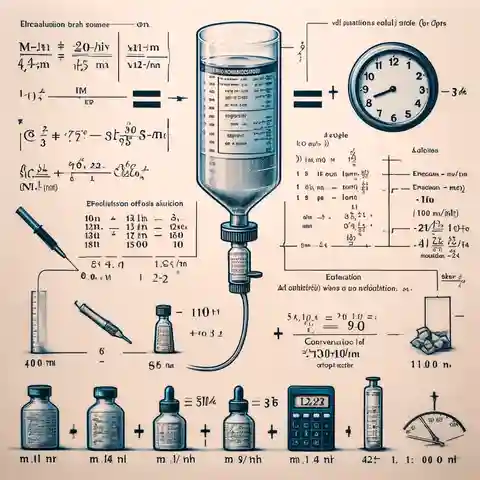Master IV infusion rate formulas! Clear explanations, examples, and why they matter for safe medication delivery.
Have you ever wondered how nurses and doctors know the right speed for IV medications? It’s all about IV infusion rate formulas! These calculations are super important for safe and effective treatment. Let’s learn the basics, figure out what ‘drop factors’ are, and see why getting this stuff right matters.
What is an IV infusion rate?

IV Infusion Rate Formulas – A medical illustration showing a healthcare professional setting up an IV drip for a patient in a hospital setting
The IV infusion rate is the speed at which a fluid or medication is delivered into a patient’s vein. It’s usually measured in milliliters per hour (mL/hr) or drops per minute (gtt/min).
IV Infusion Rate Formulas

IV Infusion Rate Formulas – An educational image visually representing the two main formulas for calculating IV infusion rates_ mL_hr and gtt_min
There are two main ways to figure out how fast to give IV fluids or medicine:
mL/hr (Milliliters per hour)
- Formula: Total Volume (mL) / Time (hours) = Infusion Rate (mL/hr)
- What it means: This tells you how much fluid to give each hour.
gtt/min (Drops per minute)
- Formula: Total Volume (mL) / Time (minutes) * Drop Factor (gtt/mL) = Infusion Rate (gtt/min)
- What it means: This tells you how many drops to give per minute.
- Important: The “drop factor” depends on the IV tubing you’re using. It tells you how many drops make up one milliliter (mL). Check the package to find this number.
Example: Calculating the Infusion Rate

IV Infusion Rate Formulas – An educational image showing a step-by-step calculation of an IV infusion rate for a given scenario
Let’s say the doctor orders 1000 mL of a fluid called Normal Saline to be given over 8 hours. You’re using IV tubing with a drop factor of 15 gtt/mL.
Here’s how to find the rate:
Step 1: mL/hr (how much fluid per hour)
- Divide the total fluid (1000 mL) by the time in hours (8 hours).
- 1000 mL / 8 hours = 125 mL/hr
Step 2: gtt/min (how many drops per minute)
- Change hours to minutes (8 hours * 60 minutes/hour = 480 minutes)
- Divide total fluid (1000 mL) by the time in minutes (480 minutes)
- Multiply that answer by the drop factor (15 gtt/mL)
- 1000 mL / 480 minutes * 15 gtt/mL = 31.25 gtt/min
- Round to the nearest whole number: 31 gtt/min
So, the answers are:
- 125 mL/hr
- 31 gtt/min
What’s a Drop Factor?

IV Infusion Rate Formulas – A detailed image explaining the concept of a drop factor in IV infusion
Imagine your IV tubing has a built-in dropper. The drop factor tells you how big each drop is. Why is this important? Because to figure out how fast to give IV fluids, you need to know if you’re dealing with big drops or tiny ones!
Here’s how it works:
- One milliliter (mL): This is a super small amount of liquid used to measure medicine.
- Drop factor: This is the number of drops it takes to fill up one mL.
Types of IV tubing:
- Macrodrip: Makes bigger drops. Think of these like water faucet drips. Common drop factors are 10, 15, or 20 drops per mL (written as gtt/mL).
- Microdrip: Makes very tiny drops. Common drop factor is always 60 gtt/mL.
Always check the package of your IV tubing to find its drop factor. You need this number to calculate the correct drip rate for your patient.
Why is it important to calculate the IV infusion rate?
Here’s why getting the IV infusion rate right matters:
- Safe and correct dosage: The right rate makes sure the patient gets the exact amount of medicine or fluid the doctor ordered.
- No overdoses or ineffective treatment: Giving the medicine too fast can be dangerous. Giving it too slow might not work as well.
- Following the doctor’s plan: Calculations help nurses give the treatment within the timeframe the doctor set. This often matters for the medicine to work properly.
- The best patient care: Getting infusion rates right is a key part of providing safe and good medical care.
How to determine the correct infusion rate
- Start with the doctor’s instructions: Your doctor will tell you exactly what fluid or medicine to give, how much, and how long it should take.
- Choose your formula: Remember, choosing the right IV infusion rate formula depends on whether you need drips per minute or milliliters per hour.
- Know your drop factor (if needed): The drop factor tells you how many drops of fluid make up one milliliter. Check the tubing package because it depends on the type of tubing used.
- Do the math! Plug the numbers from your doctor’s order into the correct formula. There are handy online calculators to help if doing the math by hand seems tricky.
Are there any online calculators or tools to help?
Many websites offer free IV infusion rate calculators. These can save you time and reduce the risk of calculation errors. Search for “IV infusion rate calculator” for reliable options.
Remember, always consult a healthcare professional for IV medication administration. For practice and learning, try out online IV infusion rate calculators!
Troubleshooting Tips: Common Mistakes and How to Avoid Them
Even with the best intentions, calculating IV infusion rates can sometimes get tricky. Here are some common slip-ups and how to prevent them:
- Misreading the Order: Double-check the doctor’s instructions! Make sure you have the correct medication, the right amount, and the timeframe they want it given over.
- Mixing up Units: Remember, sometimes you need milliliters per hour (mL/hr) and sometimes drops per minute (gtt/min). Pick the right formula based on what the doctor ordered.
- Forgetting to Convert: If you need drops per minute, but the order is in hours, make sure to convert hours to minutes (1 hour = 60 minutes).
- Math Errors: We all make them! Use an online calculator or have a nurse or doctor double-check your work, especially if you’re unsure.
Getting IV infusion rates right is crucial for patient safety. When in doubt, never hesitate to ask a medical professional for help!
Pediatric Considerations: Why Extra Care is Needed for Children
Figuring out IV infusion rates for kids is even trickier than for adults. Here’s why:
- Smaller Bodies: Kids are smaller, so they need super precise amounts of medicine or fluids. Tiny changes in how fast the medicine goes in can make a big difference.
- Special Formulas: Sometimes, doctors use different formulas to figure out the right dose for kids based on how much they weigh.
- Close Monitoring: Nurses and doctors keep a close eye on kids getting IV medications. They make sure the child is safe and the medicine is working properly.
Always leave the calculations and giving the medicine to trained healthcare professionals. But, knowing the basics helps you understand why they take extra care with your child.
Advanced Calculations: When Things Get More Complex
The basic IV infusion rate formulas work for lots of situations. But sometimes, things get more complicated. Here’s a glimpse of that:
- Weight Matters: How much a person weighs can change how much medicine they need. This is especially important for kids, so doctors might use special formulas.
- Changing Conditions: If a patient isn’t doing so well (like if their blood pressure changes), the IV rate might need to be adjusted often.
- High-Risk Medications: Some strong medicines need to be given at a very exact speed and watched constantly. These are usually given in special hospital units.
The basic IV formulas are helpful, but medicine can be tricky! That’s why doctors and nurses train for a long time, so they can safely give medications in any situation.
Technology in Infusion Delivery: Smart Pumps and Safety
You might picture IV medications dripping from a bag, but hospitals often use special machines called infusion pumps. Here’s what you should know:
- Pumps do the Math: You program the pump with the medication, the amount, and how long it should take. The pump does the calculations and delivers the medicine at the perfect rate.
- Built-in Alarms: Pumps have alarms that go off if something isn’t right, like if the IV line gets blocked or the medicine runs out.
- Humans are Still Key! While pumps are amazing, nurses and doctors still need to set them up correctly and make sure the patient is doing well. Understanding infusion rates helps them double-check the pump’s work.
Technology makes giving IV medications safer and more precise. However, it doesn’t replace the knowledge and careful monitoring of healthcare professionals.
Patient Education: Understanding Your Treatment
If you or a loved one will be receiving IV medications, feeling informed can help you feel more in control. Here’s why knowing about infusion rates matters:
Asking Questions: Understanding the basics helps you ask your doctor or nurse questions like:
- “How fast should this medicine be going in?”
- “What should I do if I notice the IV bag is empty or the machine is beeping?”
Peace of Mind: Knowing that there are calculations behind the rate of your medication can be reassuring.
Being Part of Your Care: Informed patients are better partners in their own treatment!
Always defer to your doctor and nurses for instructions and specific medical advice. This information is meant to empower you, not replace their expertise.
FAQs: About IV Infusion Rates
How do I know if an IV infusion rate is too fast or too slow?
Trust your healthcare provider. They’ll monitor the patient closely. However, if you’re concerned, don’t hesitate to ask!
Are there different formulas for different types of medications?
The core formulas stay the same, but your doctor might adjust the dose based on the specific medicine or the patient’s needs.
What if the patient’s condition changes during the infusion?
Nurses and doctors keep a close eye on patients. They might need to adjust the infusion rate if things like blood pressure or heart rate change.
Can patients play a role in their IV treatment?
Absolutely! Being informed and asking questions like “Is this a normal drip rate?” makes you an active partner in your care.
What other factors might affect IV infusion rates?
Things like the type of IV line used, specific instructions from the doctor, or the patient’s health history can all play a role.
Conclusion
Knowing how IV infusion rate formulas work is a big part of giving the best care to patients. By understanding the formulas and drops, you help make sure they get the right medicine safely. Online calculators can help, but always double-check everything with a doctor or nurse!


